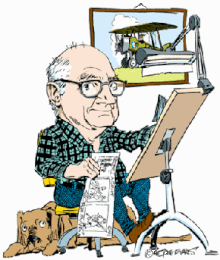George Evans (cartoonist)
| George Evans | |
|---|---|

In this self-portrait, George Evans holds a Secret Agent Corrigan comic strip.
|
|
| Born | George R. Evans February 5, 1920 Harwood, Pennsylvania |
| Died | June 22, 2001 (aged 81) |
| Nationality | American |
| Area(s) | Penciller |
George R. Evans (February 5, 1920- June 22, 2001) was an American cartoonist and illustrator who worked in both comic books and comic strips. His lifelong fascination with airplanes and the pioneers of early aviation was a constant theme in his art and stories.
Born in Harwood, Pennsylvania, Evans studied art from a correspondence course. He was still in his teens when he made his first sales, both illustrations and writing, to pulp magazines. Early in World War II, Evans was an aircraft mechanic at Shaw Field in South Carolina, where he sometimes flew in the planes he had worked on. He studied at the Scranton Art School and then entered the Army.
In the post-World War II years, Evans began working for comic books, including an in-house staff position at Fiction House until 1949. Originally hired to rule panel borders, erase pencils and fill in blacks for other illustrators, he sat next the teenaged artist Frank Frazetta. Evans eventually got up the nerve to show his portfolio to the editor where the surprised staffer exclaimed, "What the hell are you doing this job for, when you can draw like this?" After that, Evans was given feature stories to draw in 1947. Among the features he illustrated were "The Lost World in Planet Comics and "Tigerman" in Rangers Comics. His favorite work from this period was for Fiction House's Wings Comics and he did a few illustrations for the company's pulp line as well. He picked up odd jobs while still attending art classes, including some farmed out to him by Better Publications' art editor Graham Ingels, who would later join Evans at Fiction House and at EC Comics. Evans' titles for Fawcett included the When Worlds Collide film adaptation and the Captain Video television adaptation, plus horror stories for Strange Suspense Stories, This Magazine Is Haunted, and Worlds of Fear. He contributed to the company's westerns and romance titles as well. Until the end of his life, Evans believed his work for Fawcett was better than any other in his career. He liked the people there and assembled a team of inkers and assistants after becoming one of Fawcett's top illustrators in 1950.
...
Wikipedia
